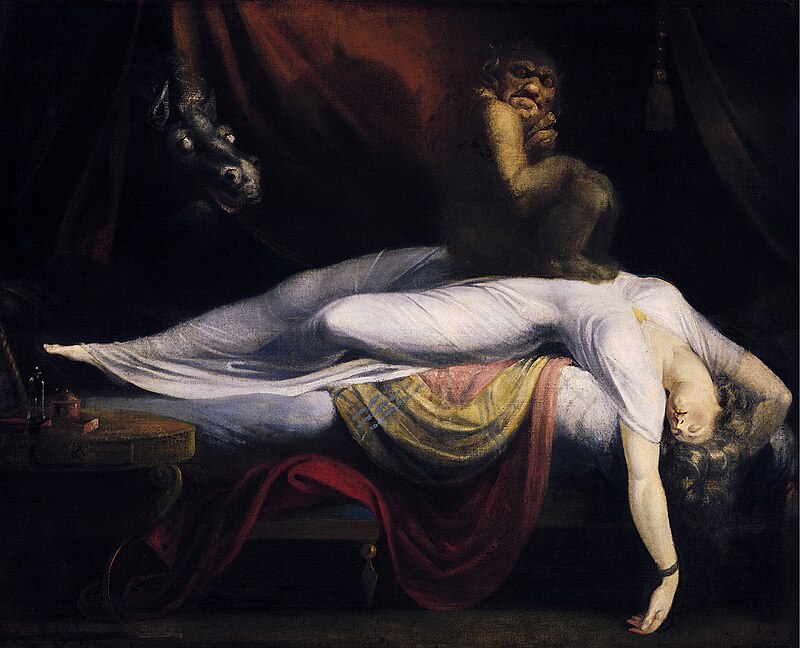
Sigmund Freud (credit: Wikimedia Commons)
All of this may seem bad enough, but it gets worse.
The third significant way in which Science eroded Religion came when Science
began to understand the workings of the human brain. Humans had long felt that
many things in this world could not be explained in physical terms because they
had long known that inside the privacy of their minds, they had dreams and
feelings, and even outside in physical reality, they sometimes saw or did
things, that by logic alone made no sense. Cruel or lustful thoughts and acts were
bad enough, but at least they seemed somewhat predictable, given humans’ “sinful”
nature. From long experience, we’ve come to know our instinctive human drives,
so we can often accept intermittent thoughts of fornication, theft, violence, and
even murder as natural. But people also have much weirder dreams and even see
weird things when they’re wide awake that are, by the laws of Physics and
common sense, not possible.

The Nightmare (Fuseli) (credit:
Wikipedia)
Why do people have dreams and waking visions of
angels or demons hovering in the air, or of talking cats on mountaintops bathed
in orange light and standing on their hind feet? Night after night, many of us dream
not just cruel or lustful dreams, but also many more that are simply absurd. Other
people, wide awake, see angels, demons, and miracles. For centuries, if a
person saw or did something that afterward he himself could not make sense of,
the widely accepted explanation was that God (or Satan) had caused the event or
had made him do the deed. Much of normal human experience, apparently, lies
beyond Science and even common sense.
When Freud came along, his big contribution to
human knowledge was simply the proposition that all these perceptions come from
inside the brain of the person having the dream or vision. Thus, visions and
miracles can be easily explained. They come from stored-up memories that combine
and recombine to form symbolic narratives that are driven by deep, unconscious
needs—needs that the visionary isn’t aware of because they are buried so deeply
she can’t consciously access them, no matter how she tries. Under stress, her
brain transmits images into her optic nerves, which is the opposite of what
usually happens. Thus, even wide awake, we can sometimes see what in physical
reality is not there.
Most of our memories may not be recallable at will,
but they are all in there. Unless a person has had some brain-destroying injury
or disease, her brain holds all she has ever experienced, all the sense data
that have ever been fed into it via sight, sound, touch, smell, and taste. How
they will affect her moment-by-moment flow of consciousness can’t be exactly
predicted in advance, but the patterns in those “paranormal” experiences coincide
too often and too closely with the subject’s personal issues for us to believe
that those experiences are somehow independent of the mental states that
preceded them.
People
have visions of angels when they have been reading about miraculous cures for
the very troubles that they have been suffering under for the last year. They
dream of tidal waves after watching a t.v. show about a recent big one in
Japan. They see the ghosts of their dead fathers after days of feeling guilty
for how they neglected him while he was alive – just before what would have
been his 80th birthday. The sciences of the mind have shown
us convincingly that we can literally see what we want/need to see.
While at first, Freud and his followers were widely
considered to be sex-obsessed crackpots, they soon began to gain credibility
and command respect, mainly because they were getting results. Their models could
explain all of human behavior, they could make high probability predictions
about how individuals with certain backgrounds would act in specific future
situations, and they began to cure people of neuroses and psychoses that, in
earlier times, would have been pronounced hopeless.
Then, as research on the human brain advanced, other
researchers showed that the model portraying all of a person’s experiences as
being stored in his brain, even though he can’t recall the experiences at will,
is literally true. Patients willing to stay conscious during neurosurgery,
allowing researchers to place tiny electrodes on their brains, are able, when a
milliamp current is turned on, to recall all kinds of memories in detail,
memories of which they ordinarily have no conscious awareness.6
Freud went much further with his psycho-sexual
explanations of nearly all of the motives that drive human behaviour. Much of
what he had to say has today been discredited; for example, we no longer
believe that little girls are consumed with a desire to have a penis. But the larger
impact of his discoveries remains. Those parts of human experience that for so
long had seemed to defy logic and common sense turned out to have a rational
explanation. The dreams and visions were, and are, figments of overactive human
imaginations; they never actually took place at all. No more miracles.
No comments:
Post a Comment
What are your thoughts now? Comment and I will reply. I promise.